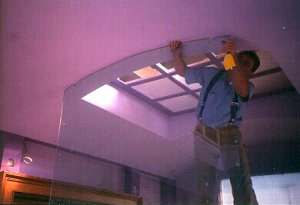skylight glazing

When selecting a skylight for your home, it's important to consider what type of glazing you should use to improve your home's energy efficiency. Based on various skylight design factors – such as its orientation and your climate – you may even want different types of glazing for different skylights throughout your home.
Skylight glazing usually consists of either plastic or glass. Other glazing technologies may also be used for solar heat control.
Plastic glazing
Plastic glazing is usually inexpensive and less liable to break than most other glazing materials. However, these plastic surfaces scratch easily, and they may become brittle and discolored over time. Many plastics also allow most of the ultraviolet (UV) rays in (unless the glazing is coated with a special film), which increases fading damage to furnishings. Acrylics and polycarbonates are the most commonly used plastic glazing. Acrylics are weaker than polycarbonates, but cost less. Although polycarbonates offer high impact resistance, some yellow with age.
Glass
Glass is usually found on the more expensive skylights. Glass is more durable than plastics and does not discolor. All glass used for skylights must be made of "safety glazing," a generic term for both tempered and laminated glass. Tempered glass is the most impact resistant. Laminated glass is fabricated with a thin layer of plastic embedded near the center of the glass. Both keep the glass from breaking into large, sharp pieces. Skylights are often made with a tempered glass on the exterior side and a laminated pane on the interior side. This arrangement gives maximum impact resistance while protecting occupants from falling shards of glass.
Solar heat control glazing
Because skylights are located on the roofs, they can result in large amounts of unwanted summer time solar heat gains and winter time heat losses. Manufacturers use various glazing technologies to reduce these impacts. The most common technologies include those also used for window glazing:
• Heat-absorbing tints
• Insulated glazing (double-glazed, triple-glazed)
• Low-emissivity (low-E) coatings
Some manufacturers even install a translucent insulation material between several glazing layers to create a more thermally efficient assembly.
